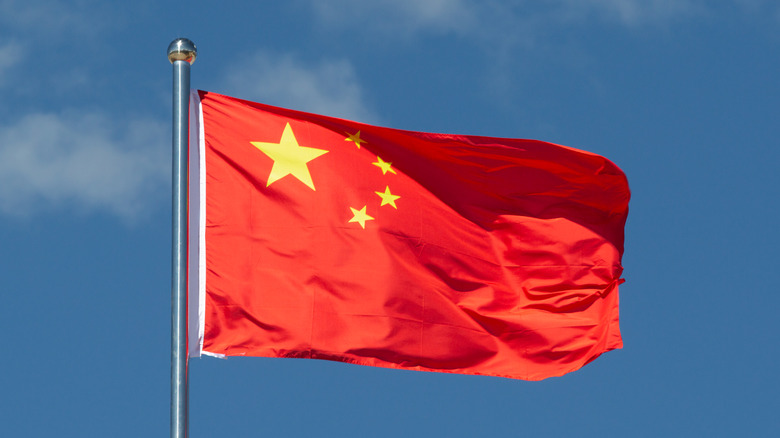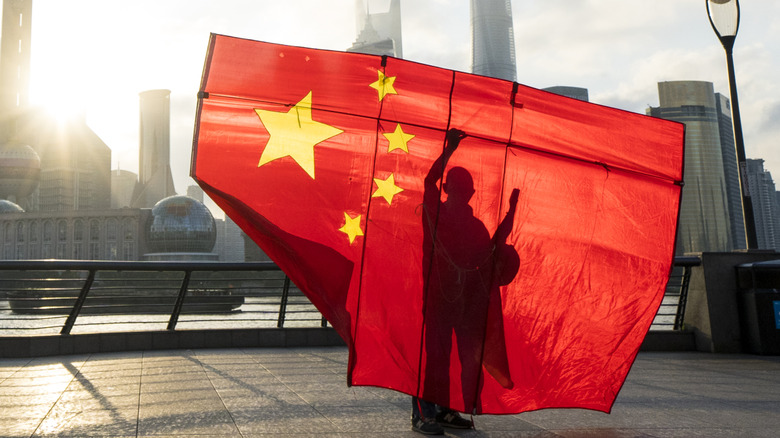The Meaning Of China's Flag Explained
The Chinese flag is striking in its simplicity — five yellow stars on a red background. Each has five points, with one large star perched in the upper-left corner and four smaller stars forming a crescent shape to its right.
Though China's recorded history goes back over 4,000 years, this particular flag has only symbolized the nation since 1949. It was created when the Chinese Communist Party declared victory over the Nationalist Party after decades of tensions and violence that eventually erupted into a civil war between the two factions. Once the CCP, led by Mao Zedong, came into power, a new flag was in order. In the re-branded People's Republic of China, it made sense to invite the public to design a flag that would represent the nation's burgeoning identity, so a contest was announced in the People's Daily.
There were roughly 3,000 entries, and the winning design went to a man named Zeng Liansong — with a small change. Zeng's original design had a red hammer and sickle inside the large star, a shout-out to the USSR, the major Communist power of the time. Mao Zedong wanted the flag to show independence from other nations, so they got rid of the hammer and sickle, and the design became what we see today. Zeng was inspired by a Chinese proverb — "longing for the stars, longing for the moon" — but there is much more behind the colors and symbols on the flag.
Red has a long history as a beloved color in China
The color red has been celebrated in China for centuries. It's believed to embody the positive aspects of life, from fertility and good fortune to prosperity and power, and even ward off bad energy. In Chinese culture, red is still a popular color for wedding dresses and is generally seen in abundance in any celebratory situation. Those aren't the reasons it's cited to be the primary color of the Chinese flag, but it has such a strong history in the nation that it's no great leap to see why it also came to symbolize the communist party itself, hence its dominance on the field of the flag. Not only that, but red is also the color of the Han people, which is the majority ethnic group in China — and in the entire world — with 1.4 billion living people from the lineage.
At its heart, the ideology behind communism, despite being a controversial system of government, has to do with sharing power and prosperity among the peasants and working class rather than those things being consolidated by the ruling classes. While the ideals have not always worked as well in practice as they do on paper, it's understandable how people in the lower socioeconomic stratosphere could get behind the movement, and in China, many of them did. Therefore, the Chinese flag that was established in 1949 pays homage to the people of China from all walks of life. That's made evident in the meaning of the yellow stars.
The 5-pointed yellow stars represent different groups of people
The five stars on the Chinese flag each symbolize the people or groups that make up the Chinese Communist Party. The biggest star represents the party itself, and the four smaller stars in its orbit signify four classes of people that are part of the CCP: the peasants, the proletariat, the petty bourgeoisie, and the "patriotic capitalists," according to Britannica. Another way to understand those groupings is described by The World of Chinese as the workers, the farmers, the intellectuals, and the businesspeople. Besides the fact that yellow really pops against a red background, the color has always been prominent among the royalty of China and was very popular throughout the culture's history. It's said to represent prosperity and optimism.
The five-pointed stars are also said to embody the five elements in Chinese philosophy: Earth, fire, wood, metal, and water. On the flag, we see five stars, each with five points. Together they exemplify national unity with the Communist Party as the focal point. The stars also pay homage to the country's long history and hope for the future.


